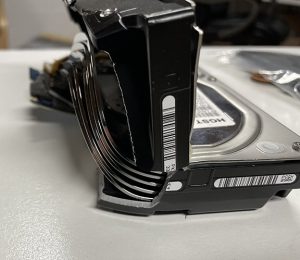Once a computer has outlived its useful life and has no value either as a spare machine or as a donation, it’s time to discard it. All computers end up here eventually. So what happens when it’s time to throw your computers away? First, don’t throw them away with the garbage! There are metals and chemicals in computer parts that are really bad for the environment. Your best bet is to take them to a local recycling center that handles computer recycling or “E-Waste”. As a service to our clients, we pick up their end-of-life computer equipment and facilitate its recycling.
But what about the data that’s on those computers? It’s old, but I don’t want it floating around in the world. I’m glad you asked, because this is really important. You definitely don’t want your data out in the world. When we facilitate recycling for our clients, we bring the computers back to our office, open them up and remove the hard drives, and then make them look like this -

When we bend the drive’s platters (disks) in this way, we ensure that they can never be made straight enough to be read again.
But what about SSDs? Indeed. Those are storage as well and need the same attention to make sure your data isn’t disclosed. For SSDs, we disassemble them and pull out the circuit board that contains all the storage chips. We then use bolt cutters to physically cut the storage chips in half so they can no longer be read.
If you have computers to be recycled, don’t just throw them out. Recycle them - but only after you’ve made your data inaccessible.



